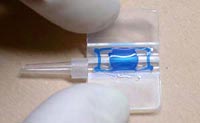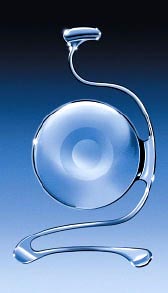Intraocular surgery offers more precise vision correction technology
|
|
Often, eye physicians make reference to refractive surgery’s changing medium and the sculpting of the eye to reduce the refractive error as an art. Modern surgical advances have empowered physicians to broaden the media to create even greater masterpieces. Metaphorically, refractive surgery was limited to sculpting the cornea, with blades and lasers, to treat ametropia. However, intraocular surgeries have advanced the boundaries and have created more opportunities with more precise measurements and technologically advanced lenses that can cure presbyopia.
Previously, Dr. Paul Karpecki wrote about some of these new lenses that have been approved by the Food and Drug Administration. Yet the technological boom has created a flood of innovative lenses that will significantly affect our patients’ lives. Some of these lenses are fitted as pseudophakic options and some as phakic options. As clinicians, it is important that we keep our eyes on the whole picture.
Accommodative IOL choices
Realizing that the baby boomers are well into their presbyopic years, the lens revolution must enable both distance and near visual recovery. With that in mind, the Kellan Tetraflex KH3500 accommodative IOL, from Lenstec, is made of a poly-HEMA acrylic with 26% water content. The Tetraflex is based on the same principles that Dr. Cummings has demonstrated as the driving force behind the Crystalens (eyeonics, Aliso Viejo, Calif.). Thus, the lens uses the forces of vitreal displacement to shorten the focal length of the visual system. The KH3500 can be inserted into the posterior chamber with an injector through a 2-mm to 2.5-mm incision.
|
|
Testing in Europe has proven that this lens can be a formidable player in the quest to cure presbyopia with distance-corrected near visual acuity of J3 or better in 40% of eyes. The uncorrected distance acuity of 20/40 or better was achieved in 83% of the eyes. Clearly, this lens performs similarly to other pseudoaccommodating lenses with excellent distance correction and good binocular close vision. Lenstec is preparing to start clinical trials in the United States.
The 1CU Akkommodative IOL (HumanOptics AG, Erlangen, Germany) was developed to transmit the ciliary body’s contracting forces into anterior movement of the lens optic to achieve pseudophakic accommodation. Does this sound familiar?
This one-piece, bioconvex lens made of hydrophilic acrylic with an ultraviolet inhibitor has an optical diameter of 5.5 mm and an overall diameter of 9.8 mm. The lens haptics are modified with transmission elements at their fusion with the lens optic.
|
|
The 1CU IOL is CE-approved and was implanted for the first time in June 2000 at the University Eye Hospital of Erlangen-Nuremberg University. With more than 1,200 patients implanted in Italy, Japan, Greece, Finland, the United Kingdom and Germany, the 1CU has proven its results can stand up to any FDA-approved accommodating lens. Future use of this lens in the United States will be determined shortly by the FDA.
Advances in lens design
Visiogen Inc. (Irvine, Calif.) has taken the presbyopic lens design one step further with the development of the Synchrony. This dual-optic, silicone, single-piece, foldable, accommodating lens looks like something out of the mind of George Lucas. The IOL features two optical segments connected by haptics that have a spring-like action. The optical power of the anterior optic is within the range of 30 to 35 D, and the posterior optic is assigned a variable diverging power to produce emmetropia for a given eye. This lens design relies on axial displacement of the anterior optic, similar to that of other pseudoaccommodating IOLs, in the range of 0.25 to 1 mm to achieve the accommodative effect. As previously mentioned, other lenses rely on the ciliary body directly causing the IOL to vault forward.
According to this thinking, either the ciliary body presses on the lens or the contraction of the ciliary muscle generates a pressure gradient between the aqueous and vitreous, which causes anterior displacement of the lens zonular diaphragm and steepening of the anterior central lens curvature. Theoretically then, the amount of excursion generated (usually between 0.4 and 0.7 mm) limits the accommodative range of a single-optic design (such as the Crystalens, Tetraflex and Akkommodative 1CU).
A dual-optic system, such as the Synchrony, with a highly powered anterior optic, does not need such a large excursion to achieve adequate intermediate and near focus. As a result, this design is thought to improve image quality at all distances. One could argue that a major deficit with the current accommodative designs is the lack of true near vision. However, we should see an increase in the amplitude of accommodation that is lacking with current designs with the Synchrony. Incidentally, the new multifocal lenses (ReStor [Alcon, Ft. Worth, Texas] and ReZoom [AMO, Irvine, Calif.]) boast an improvement in the near add and yet conversely leave the intermediate distance somewhat lacking.
Discarding crystalline lenses
However, we still have to determine whether people are ready to discard their crystalline lenses for an implant. Better yet, we still have to determine whether they should have to. With better advances in multifocality, as demonstrated by the ReStor and the ReZoom, phakic lens technology has jumped on board. This technology can bridge the gap for early presbyopes as well as provide an opportunity to piggy-back IOLs for bioptic intraocular correction. For example, one could combine the Staar toric IOL (Monrovia, Calif.) with the anterior chamber phakic Verisyse (AMO, Irvine, Calif.) so that myopic astigmatic corrections can be achieved without affecting the cornea.
Using phakic lens technology, IOLTech has adapted the three-piece Vivarte lens into a multifocal phakic IOL. This single-piece acrylic lens is angle supported with flexible haptics and a foldable hydrophilic optic section. The ability to fold enables the lens to be inserted through a self-sealing 3.5-mm corneal incision, thus avoiding induced astigmatism and sutures. This lens also boasts multiple diameters (12, 12.5, 13.0 mm), an optic diameter of 5.5 mm and refractive ranges of –6.5 to –31.00 D in 0.5-D steps.
|
|
Although fairly early in their clinical trials, the three-point touch seems to have reduced the endothelial changes previously seen with other designs. With the foldable insertion and healthy range of myopic refractive errors, this lens may prove to be a valuable tool. The new lenses’ bifocal components consist of a central area for distance vision, a ring for near vision with a 2.5-D add and an additional ring for distance vision. The lenses are available for myopia up to –5.0 D and hyperopia up to +5.0 D in Europe.
In a European study of 40 eyes in 25 patients who underwent implantation of the Vivarte, uncorrected visual acuity improved from a preoperative value of 20/40 to 20/25 after a follow-up of at least 2 months. In addition, 75% had a visual acuity of 20/30 and J1/J2 with no correction, and nearly 80% no longer wear glasses.
Future options
Lee Nordan, MD, a noted ophthalmologist from San Diego, is attempting to perfect a new phakic IOL that is one-size-fits-all and will also be multifocal. The silicone Vision Membrane has a 6-mm optic zone and bendable footplates that will fit into the anterior angle. As the footplates bend, they arch the lens away from the iris and fit snugly into the anterior angle. With the successful implantation of three lenses, Dr. Nordan hopes to bring the lens to clinical trials within the next few years.
Calhoun Vision (Pasadena, Calif.) is working on a revolutionary lens material that could set the lens industry on its heels. Using a light-sensitive polymer that is imbedded with macromeres, the material is capable of being altered in vivo. In other words, this light-adjusted lens can be inserted into the capsular bag (in whatever form the IOL is designed), and the refraction can be taken 1 to 2 weeks postoperatively. Using a proprietary laser, the lens can alter its refractive shape up to 4 D (hyperopic, myopic or astigmatic). The clinician can recheck the refraction, and when it is determined that the lens is stable, another blast of the laser will “lock-in” the correction. This lens material will allow any lens implanted into the eye to be “fine-tuned” without further surgical intervention.
It is obvious that this barrage of new technology is going to increase the choices and refractive options for our patients. Much like art enthusiasts await a new piece from their favorite artist, the public has to wait for these new pieces of lenticular works of form and function.
For Your Information:
- Marc Bloomenstein, OD, FAAO, a Primary Care Optometry News Editorial Board member, can be reached at Barnet Dulaney Perkins Eye Center, 4800 N. 22nd St., Phoenix, AZ 85016; (602) 955-1000; fax: (602) 508-4744; e-mail: mbloomenstein@bdpec.com. Dr. Bloomenstein has no direct financial interest in the products mentioned in this article, nor is he a paid consultant for any companies mentioned.
- Lenstec, manufacturer of the Kellan Tetraflex KH3500 IOL, can be reached at 2870 Scherer Dr., Suite 300, St. Petersburg, FL 33716; (727) 571-2272; fax: (727) 571-1792; e-mail: lenstec@lenstec.com; www.lenstec.com.
- HumanOptics, manufacturer of the 1CU IOL, can be reached at Spardorfer Strasse 150, 91054 Erlangen, Germany; 49-9131-506-650; fax: 49-9131-506-6590; e-mail: mail@humanoptics.com; www.humanoptics.com.
- Visiogen, manufacturer of the Synchrony IOL, can be reached at 4 Jenner St., Suite 180, Irvine, CA 92618; (949) 341-0700.
- IOLTech Laboratories, manufacturer of the Vivarte lens, can be reached at Avenue Paul Langevin – BP 5 17053, La Rochelle Cedex 9, France; 33-05-46-44-85-50; fax: 33-05-46-44-85-60; e-mail: contact@ioltech.com; Web site: www.ioltech.com.
- Calhoun Vision Inc. can be reached at 2555 E. Colorado Blvd., Pasadena, CA 91107; (626) 685-2000; fax: (626) 685-2003; e-mail: info@calhounvision.com; www.calhounvision.com.

![Marc Bloomenstein, OD, FAAO [photo]](/~/media/images/news/print/primary-care-optometry-news/2005/02_february/bloom_60_90_75442.jpg)



